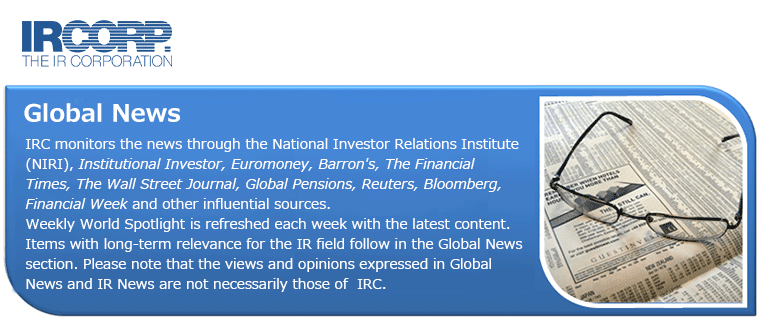The Economist (December 3)
As the European “crisis deepens, an alarming prospect looms: that France’s own status could lapse, and thus its clout at the heart of the euro zone. France is by far the most vulnerable of the zone’s six AAA-rated countries.” Many French officials are still pretending a downgrade is unthinkable, but Moody’s has placed France’s rating on watch. In another worrying move, the OECD “cut its 2012 GDP growth forecast for France from 2.1% to just 0.3%, well below the 1% on which the government based its latest austerity plan.” With some forecasting recession, the French could find themselves in the vice of decreased revenue and increased financing costs.
As the European “crisis deepens, an alarming prospect looms: that France’s own status could lapse, and thus its clout at the heart of the euro zone. France is by far the most vulnerable of the zone’s six AAA-rated countries.” Many French officials are still pretending a downgrade is unthinkable, but Moody’s has placed France’s rating on watch. In another worrying move, the OECD “cut its 2012 GDP growth forecast for France from 2.1% to just 0.3%, well below the 1% on which the government based its latest austerity plan.” With some forecasting recession, the French could find themselves in the vice of decreased revenue and increased financing costs.
Tags: Credit rating, Europe, France, Moody's, OECD
USA Today (August 7)
“The United States’ unquestioned AAA credit rating is gone, for the first time ever.” S&P’s downgrade was not a surprise, instead it “merely confirmed what anyone with their eyes open for the past decade or two already knew: The U.S. has a huge and growing debt problem that it is resolutely unwilling to solve.” USA Today points out one silver lining. The U.S. is not incapable of solving this problem, merely unwilling. Another silver lining is that two major agencies (Moody’s and Fitch) still assign the highest rating to U.S. debt, which continues to be highly sought by investors worldwide.
Financial Times (July 10)
Ratings agencies have come under considerable criticism since the Lehman crisis. Most recently, European leaders have heaped scorn on them after Moody’s downgraded Portugal to junk and S&P evaluated a proposal for a Greek debt rollover as a selective default. This time, the ratings agencies are addressing truths that are difficult to stomach. “We have to thank the rating agencies for giving the eurozone’s policymakers a clearer vision of which strategies are feasible, and which are not. It is now time to get serious.”
Wall Street Journal (May 14)
The WSJ hopes Nationally Recognized Statistical Ratings Organizations (NRSROs) will be eliminated. NRSROs include organizations such as S&P, Moody’s and Fitch which “put triple-A seals of approval on dubious securities at the heart of the financial panic.” In a promising development, a Senate amendment, which would eliminate NRSROs from U.S. laws and regulations, passed by 61-38.
The WSJ hopes Nationally Recognized Statistical Ratings Organizations (NRSROs) will be eliminated. NRSROs include organizations such as S&P, Moody’s and Fitch which “put triple-A seals of approval on dubious securities at the heart of the financial panic.” In a promising development, a Senate amendment, which would eliminate NRSROs from U.S. laws and regulations, passed by 61-38.
New York Times (May 2)
Lashing out at Wall Street Banks is now an American pastime, but the credit ratings agencies “bear as much responsibility for the financial crisis as the banks.” Largely forgotten is the role Moody’s, S&P and Fitch played. Investors and financial institutions would never have purchased as many mortgage-backed securities and collateralized debt obligations (CDO’s) had the raters properly warned investors that these were essentially “high-tech junk bonds,” rather than triple-A securities. Current proposals aimed at reforming the ratings agencies are not enough. The newspaper supports drastic steps to improve the ratings system.
Lashing out at Wall Street Banks is now an American pastime, but the credit ratings agencies “bear as much responsibility for the financial crisis as the banks.”
Largely forgotten is the role Moody’s, S&P and Fitch played. Investors and financial institutions would never have purchased as many mortgage-backed securities and collateralized debt obligations (CDO’s) had the raters properly warned investors that these were essentially “high-tech junk bonds,” rather than triple-A securities. Current proposals aimed at reforming the ratings agencies are not enough. The newspaper supports drastic steps to improve the ratings system.
Tags: Banks, CDOs, Fitch, MBS, Moody's, NRSROs, Ratings agencies, S&P, U.S., Wall Street
New York Times (April 26)
Nobel winner Paul Krugman writes rating agencies, such as Moody’s and S&P, were at the heart of the financial crisis. “Of AAA-rated subprime-mortgage-backed securities issued in 2006, 93 percent….have now been downgraded to junk status.” E-mails show the ratings agencies bent rules to get business and “skewed their assessments to please their clients.” Krugman calls for fundamental reform of the corrupt ratings system.
Nobel winner Paul Krugman writes rating agencies, such as Moody’s and S&P, were at the heart of the financial crisis. “Of AAA-rated subprime-mortgage-backed securities issued in 2006, 93 percent….have now been downgraded to junk status.” E-mails show the ratings agencies bent rules to get business and “skewed their assessments to please their clients.” Krugman calls for fundamental reform of the corrupt ratings system.
Tags: Moody's, NRSROs, Ratings agencies, S&P


